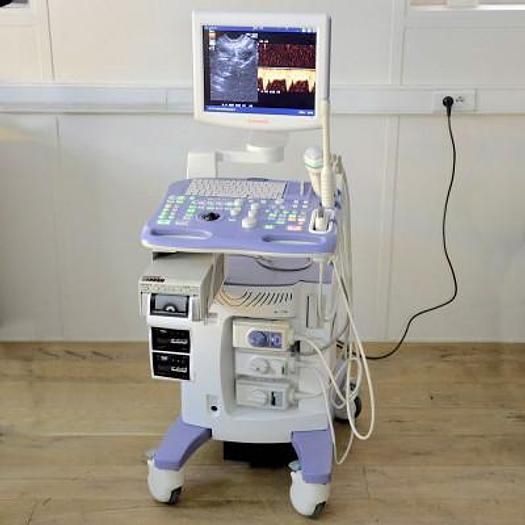Aloka, Hitachi Prosound 3500SX
EUROPE (Western and Northern)
with:
- 3D/4D abdominal volume probe
- 2D abdominal convex probe
- 2D endovafgianle probe
- Sony B&W printer Ergonomics:
The compact and lightweight system can be moved easily.
The flicker-free display monitor reduces eye fatigue.
The control panel and viewing screen can
be shifted up/down for your optimal position.
3D/4D Imaging Imaging the fetus in motion,
in real time by high-speed scanning.
The viewpoint of a 3D image can be freely rotated 360
degrees horizontally and vertically.
The images you want to see, such as the face of a fetus,
can be easily displayed regardless of the position of the fetus.
The MPR (Multi Planar Reconstruction) allows the
simultaneous display of three arbitrary orthogonal sections,
which allows the observation of the coronal section which is
impossible to analyze with 2-dimensional scanning.
A single 4D probe is used for all routine examinations,
Doppler, Color Flow and 4D. Real-time FAM
(Free Agular M-Mode) Up to three M-mode cursors are
individually moved and rotated during scanning for
fast and accurate M-mode examination.
For example, the heart function of a fetus is
easily checked regardless of its orientation.
Network and digital data management
The system is compatible with DICOM 3.0.
Patient data and image data can be transmitted to
the file server in the network.
The latest measurement data and ultrasound images can
be quickly retrieved from the built-in hard disk.
Tissue Harmonic Echo (THE) The Tissue Harmonic Echo
reduces defects caused by near-field multiple echoes and
side lobes. Quint Imaging Frequency (QFI) The QFI allows the
selection of optimal frequencies over an extremely wide
range of the probe bandwidth. It is possible to
select higher resolution images or penetration imaging
depending on the situation without changing the probe.
QFI works not only on black and white images,
but also on color flow images and Harmonic Echo images.
DDD (Dual Display Dynamic) DDD is a function to
display B-mode images with and
Color Flow image simultaneously in real time.
This function is useful for ultrasound-guided biopsy as
the examination can be performed at a high frame rate and
facilitates the differentiation of hypoechoic plaque which is
difficult to diagnose by B-mode images alone.

